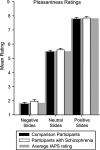Reward processing in schizophrenia: a deficit in the representation of value
- PMID: 18591195
- PMCID: PMC2518641
- DOI: 10.1093/schbul/sbn068
Reward processing in schizophrenia: a deficit in the representation of value
Abstract
Patients with schizophrenia demonstrate deficits in motivation and learning that suggest impairment in different aspects of the reward system. In this article, we present the results of 8 converging experiments that address subjective reward experience, the impact of rewards on decision making, and the role of rewards in guiding both rapid and long-term learning. All experiments compared the performance of stably treated outpatients with schizophrenia and demographically matched healthy volunteers. Results to date suggest (1) that patients have surprisingly normal experiences of positive emotion when presented with evocative stimuli, (2) that patients show reduced correlation, compared with controls, between their own subjective valuation of stimuli and action selection, (3) that decision making in patients appears to be compromised by deficits in the ability to fully represent the value of different choices and response options, and (4) that rapid learning on the basis of trial-to-trial feedback is severely impaired whereas more gradual learning may be surprisingly preserved in many paradigms. The overall pattern of findings suggests compromises in the orbital and dorsal prefrontal structures that play a critical role in the ability to represent the value of outcomes and plans. In contrast, patients often (but not always) approach normal performance levels on the slow learning achieved by the integration of reinforcement signals over many trials, thought to be mediated by the basal ganglia.
Figures






Similar articles
-
Decision-making impairments in the context of intact reward sensitivity in schizophrenia.Biol Psychiatry. 2008 Jul 1;64(1):62-9. doi: 10.1016/j.biopsych.2008.02.015. Epub 2008 Apr 2. Biol Psychiatry. 2008. PMID: 18377874 Free PMC article.
-
Reward-driven decision-making impairments in schizophrenia.Schizophr Res. 2019 Apr;206:277-283. doi: 10.1016/j.schres.2018.11.004. Epub 2018 Nov 12. Schizophr Res. 2019. PMID: 30442476
-
[Cognition, schizophrenia and the effect of antipsychotics].Encephale. 2006 May-Jun;32(3 Pt 1):341-50. doi: 10.1016/s0013-7006(06)76162-0. Encephale. 2006. PMID: 16840928 Review. French.
-
Impaired Expected Value Computations Coupled With Overreliance on Stimulus-Response Learning in Schizophrenia.Biol Psychiatry Cogn Neurosci Neuroimaging. 2018 Nov;3(11):916-926. doi: 10.1016/j.bpsc.2018.03.014. Epub 2018 Apr 3. Biol Psychiatry Cogn Neurosci Neuroimaging. 2018. PMID: 29735404 Free PMC article.
-
Cognition in schizophrenia: impairments, determinants, and functional importance.Psychiatr Clin North Am. 2005 Sep;28(3):613-33, 626. doi: 10.1016/j.psc.2005.05.004. Psychiatr Clin North Am. 2005. PMID: 16122570 Review.
Cited by
-
Avolition as the core negative symptom in schizophrenia: relevance to pharmacological treatment development.NPJ Schizophr. 2021 Feb 26;7(1):16. doi: 10.1038/s41537-021-00145-4. NPJ Schizophr. 2021. PMID: 33637748 Free PMC article. Review.
-
Spared and impaired aspects of motivated cognitive control in schizophrenia.J Abnorm Psychol. 2013 Aug;122(3):745-55. doi: 10.1037/a0033069. Epub 2013 Jul 8. J Abnorm Psychol. 2013. PMID: 23834064 Free PMC article.
-
The neural transfer effect of working memory training to enhance hedonic processing in individuals with social anhedonia.Sci Rep. 2016 Oct 18;6:35481. doi: 10.1038/srep35481. Sci Rep. 2016. PMID: 27752140 Free PMC article.
-
Performance-based empathy mediates the influence of working memory on social competence in schizophrenia.Schizophr Bull. 2014 Jul;40(4):824-34. doi: 10.1093/schbul/sbt084. Epub 2013 Jun 14. Schizophr Bull. 2014. PMID: 23770935 Free PMC article.
-
Bridging Levels of Understanding in Schizophrenia Through Computational Modeling.Clin Psychol Sci. 2015 May;3(3):433-459. doi: 10.1177/2167702614562041. Clin Psychol Sci. 2015. PMID: 25960938 Free PMC article.
References
-
- Berridge KC, Robinson TE. Parsing reward. Trends Neurosci. 2003;26:507–513. - PubMed
-
- Ongur D, Price JL. The organization of networks within the orbital and medial prefrontal cortex of rats, monkeys and humans. Cereb Cortex. 2000;10:206–219. - PubMed
-
- Montague PR, Hyman SE, Cohen JD. Computational roles for dopamine in behavioural control. Nature. 2004;431:760–767. - PubMed
-
- Holroyd CB, Coles MG. The neural basis of human error processing: reinforcement learning, dopamine, and the error-related negativity. Psychol Rev. 2002;109:679–709. - PubMed

